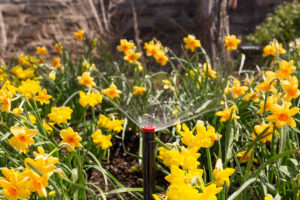Summer is packed with fun-filled days at the pool, on vacation, grilling in the backyard, and basking in the sunshine and warm temperatures. But summer can also put stress on your lawn.
Prepping your lawn for a hot summer is essential to growing a luscious, green lawn.
Clean & Remove Debris
As the seasons change, your lawn is likely to have leaves, branches, and other debris is blown about. Take a stroll around the yard to collect any toys, large sticks, piles of leaves, and trash. Rack up and dispose of what you can or add the appropriate items to your compost pile.
In addition to strewn-about debris, your yard has most likely developed a thick thatch over the winter and early spring season. Thatch is a layer of dead grass, weeds, and other decaying plant material and debris. This thick layer becomes compacted on top of your grass and can block sunlight and water from reaching the roots of the grass. Dethatch by raking up the debris and discarding it accordingly.
Build Walkways in High Traffic Areas
Summer calls for more outdoor gatherings and kids playing in the yard. Protect your turf from damage by creating walkways to and from your high-traffic areas and gathering spots. Bonus — it will add some curb appeal and pizazz to your yard.
Aerate the Soil
Aerating your lawn allows the grass to breathe and lets water and nutrients permeate deeply into the roots. Determine your grass type and aerate accordingly.
Cool-season grasses are grass types that thrive in areas with cold winters and hot summers.
Common cool-season grasses include bluegrass, ryegrass, and fescue. For cool-season grass, we recommend aerating in autumn.
Warm-season grasses typically go dormant and turn brown in the wintertime and early spring. When temperatures breach 75°, warm-season grass begins to reproduce and turn green. Bahia grass, bermuda grass, centipede grass, St. Augustine grass, and zoysia grass are some of the most common warm-season grasses. For warm-season grasses, aerate in early spring.
Apply fertilizer
After aerating your soil, apply fertilizer for added nutrients for your grass. Fertilizer type and time of application are also determined by grass type.
Cool-season grasses: Fertilize during early spring and the onset of fall. Use fertilizer with a higher nitrogen content to ensure survival in the summer.
Warm-season grasses: A nitrogen-rich fertilizer should be applied in spring and again in late summer.
Weed Prevention
Weeds are the silent killer of your luscious lawn. Weeds drain the necessary nutrients for your lawn. Manually pull the weeds by the root or apply the appropriate herbicide to the weeds in your lawn.
Mow Regularly
Lawns should be mowed roughly once a week, depending on how fast your grass is growing. In the earlier months of spring and summer, mow down to about 2.5 to 3” in height. Nearing peak temperatures of the summer, cut to about 3 to 4” in height. Cutting to a taller height will provide shade for the roots and conserve moisture in the soil.
Check the blades of your mower before each session to avoid any added stress to your grass. Dull blades will do more thrashing than cutting to the blades of grass.
Water Lawn
Depending on the rainfall in your area, your lawn will need half to 1 inch of water per week.
Put your mind at ease with an automatic irrigation system with Sprinkler Irrigation Services. Our programmed systems will monitor rainfall and will water the zones in need of more water. Save yourself the time and stress of pulling out the ole’ water hose and call the pros! Learn more about the benefits of an automatic irrigation system here.



